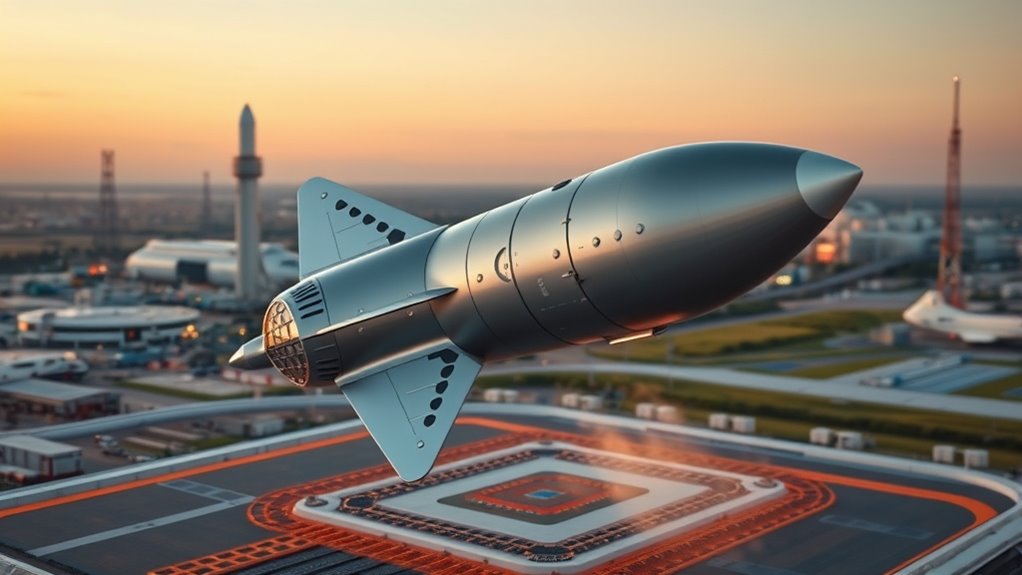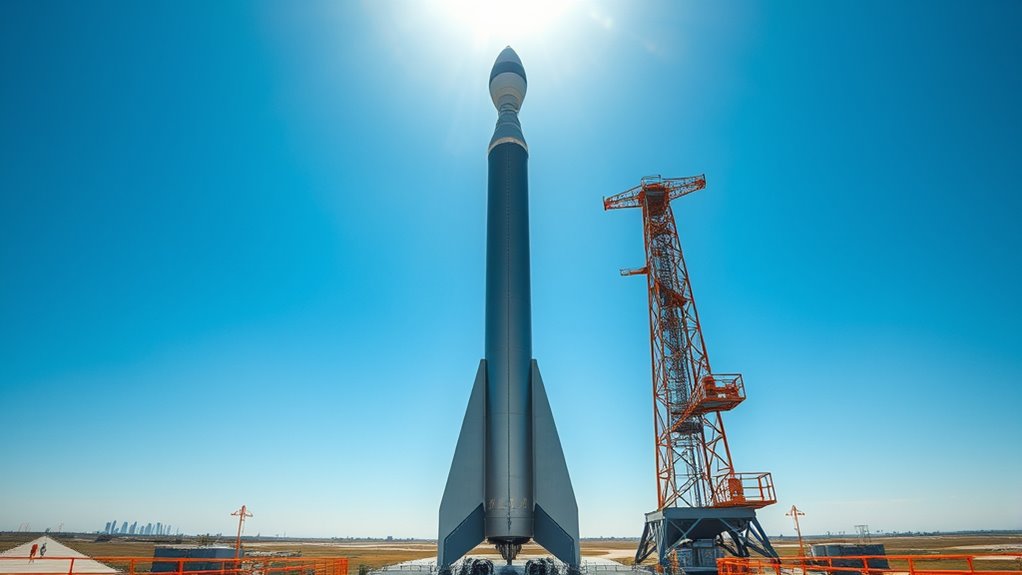Reusable rockets save money by allowing you to launch the same hardware multiple times, cutting down on the costs of materials, manufacturing, and disposal. Instead of building a new rocket for each mission, you refurbish and reuse components like boosters and engines, which markedly reduces expenses. This approach also lowers waste and environmental impact. To discover how these savings add up and what future potential they hold, keep exploring this innovative technology.
Key Takeaways
- Reusable rockets reduce manufacturing and raw material costs by allowing multiple launches with the same components.
- Cost savings stem from refurbishing and reusing major parts like boosters and engines instead of building new ones.
- Increased launch frequency lowers average costs per mission, making space access more affordable.
- Reusability decreases waste and environmental impact, reducing expenses related to disposal and resource depletion.
- Technological advancements in durability and reliability further optimize reuse, driving down long-term operational costs.

Reusable rockets are at the forefront of this shift, transforming the way we think about reaching the stars. Instead of building a new rocket for every launch, companies are now designing vehicles that can return to Earth, be refurbished, and used repeatedly. This innovation dramatically reduces the cost of space missions, making space exploration more accessible and frequent. Aerospace economists highlight that the key to this cost reduction lies in minimizing the expenses associated with manufacturing and material waste. Traditional rockets, which are discarded after a single use, involve immense costs for each launch, including raw materials, manufacturing, and labor. By reusing vital components like boosters and engines, companies cut down on these expenses considerably. This not only makes launches cheaper but also allows for more frequent missions, accelerating advancements in science and technology. Additionally, the development of reusable rockets encourages a focus on innovative engineering that enhances durability and performance over multiple flights. Moreover, the ability to rapidly refurbish and prepare rockets for subsequent launches has led to a more efficient launch process, reducing downtime and increasing mission cadence.
Beyond the financial advantages, reusable rockets also have a substantial positive impact on the environment. Launching rockets traditionally generates a considerable amount of waste, with spent stages falling back to Earth or into oceans, and the production of new vehicles for each mission contributing to resource depletion. Reusability addresses these concerns by reducing the need for manufacturing entirely new rockets for every flight. Instead, existing rockets are refurbished and prepared for their next launch, decreasing the amount of waste generated and lowering the overall environmental footprint. Aerospace experts emphasize that this approach aligns with broader sustainability goals, as it minimizes the use of raw materials and reduces emissions associated with manufacturing. Furthermore, reusable rockets tend to have more efficient designs, further cutting down on fuel consumption and emissions during launch and re-entry. According to renewable energy sources, advancements in propulsion and materials science are also supporting the longevity and performance of reusable systems.
Moreover, advancements in materials technology are crucial for extending the lifespan of reusable rocket components, enabling more flights before refurbishment. In addition to cost and environmental factors, reusable rockets are fostering innovation in the space industry. They challenge engineers to develop more durable, reliable, and efficient components capable of withstanding multiple launches and landings. This push for durability leads to technological advancements that benefit the entire industry, including satellite deployment, space station resupply missions, and even future crewed missions. As more companies adopt reusability, the space sector is becoming more competitive, driving down prices and increasing the pace of exploration. Ultimately, the shift toward reusable rockets represents a vital step toward more sustainable, affordable, and responsible space travel—an evolution that benefits not just science and industry but also the planet we call home.
Frequently Asked Questions
How Many Times Can a Reusable Rocket Typically Be Flown?
You might wonder how many times a reusable rocket can fly. Typically, it’s designed for about 10 to 20 launches before refurbishment becomes necessary. This reuse substantially reduces costs because it spreads out the initial investment over multiple flights, enhancing cost reduction. Plus, the ability to reuse rockets without sacrificing payload capacity makes space missions more economical and efficient, encouraging more frequent launches and innovations.
What Are the Main Technical Challenges of Reusability?
You face key technical challenges with reusability, mainly material fatigue and thermal protection. Material fatigue occurs from repeated launches, weakening components over time. Thermal protection systems must withstand extreme heat during re-entry, which can degrade with each use. Managing these issues requires advanced materials and precise engineering, ensuring rockets can be reused safely without compromising performance. Overcoming these hurdles is vital for making reusable rockets a reliable and cost-effective solution.
How Does Reusability Impact Launch Turnaround Time?
Imagine a rocket standing ready on the launch pad, fueled and prepared. Reusability considerably shortens launch turnaround time by streamlining refurbishment cycles, allowing you to reuse components rather than build new ones. This boosts operational efficiency, enabling quicker launches. Instead of waiting weeks for repairs, you quickly inspect, refurbish, and prepare the rocket, making the entire process more agile and cost-effective, ultimately accelerating your access to space.
Are There Environmental Benefits to Reusable Rockets?
You might wonder if reusable rockets offer environmental benefits. By reducing the need for manufacturing new rockets, they lower the environmental impact and contribute to emission reduction. Reusable rockets cut down on waste and decrease the overall carbon footprint of space launches. This sustainability makes space exploration more eco-friendly, helping you support greener technologies and practices in the aerospace industry.
What Are the Future Cost Savings Projections for Reusable Rockets?
While the future remains optimistic, you can expect ongoing cost reduction as reusable rocket technology matures. Industry analysts project that market growth will accelerate, further lowering launch prices. This trend suggests significant savings over time, making space access more affordable. As innovations continue, you’ll likely see a sustainable cycle of cost efficiency, encouraging broader opportunities and fueling new ventures in space exploration and commercial endeavors.
Conclusion
Think of reusable rockets as the penny-pinching traveler who always packs snacks for the journey. By reusing components, you cut costs like saving that extra dollar, transforming once-expensive launches into affordable routines. According to aerospace economists, this approach can slash launch costs by up to 70%. Just like that traveler, you’re making smarter choices—saving money and opening new horizons. Reusable rockets aren’t just a tech upgrade; they’re a game-changer for the future of space exploration.
Amina brings over a decade of journalism experience to her role as Editor-in-Chief. Under her leadership, Exquisite Post has flourished, maintaining the highest standards of integrity and excellence. Amina’s commitment to truth and her visionary approach guide the editorial team in producing impactful news stories that resonate with our audience.










